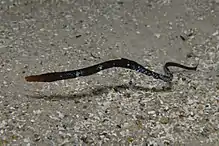| Histiogamphelus | |
|---|---|
 | |
| Histiogamphelus briggsii | |
| Scientific classification | |
| Domain: | Eukaryota |
| Kingdom: | Animalia |
| Phylum: | Chordata |
| Class: | Actinopterygii |
| Order: | Syngnathiformes |
| Family: | Syngnathidae |
| Subfamily: | Syngnathinae |
| Genus: | Histiogamphelus McCulloch, 1914 |
| Type species | |
| Histiogamphelus briggsii McCulloch, 1914 | |
Histiogamphelus is a genus of fish known as the crested pipefishes. They belong to the family Syngnathidae and are endemic to the southern coast of Australia and Tasmania. They have a characteristic "crest" on the snout, which can help distinguish them from other related genera within the sub-family Syngnathinae. Their brown-tan coloration may mimic the Posidonia sea grass in which they are often found. Like all syngnathids, the male broods the eggs in a brood pouch (in this genus located under the tail).
Species
There are currently two recognized species in this genus:[1]
- Histiogamphelus briggsii McCulloch, 1914 (Briggs' pipefish)
- Histiogamphelus cristatus W. J. Macleay, 1881 (Macleay's crested pipefish)
References
- ↑ Froese, Rainer and Pauly, Daniel, eds. (2012). Species of Histiogamphelus in FishBase. October 2012 version.
This article is issued from Wikipedia. The text is licensed under Creative Commons - Attribution - Sharealike. Additional terms may apply for the media files.